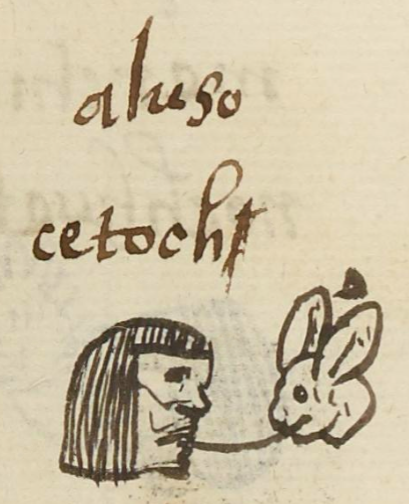Cetoch (MH506r)
This black-line drawing of a combined simplex glyph and notation for the personal name (and date) Cetoch (or Ce Tochtli, One Rabbit, 1-Rabbit) shows a rabbit (tochtli) head in profile facing the viewer's left. It has long ears. Above its head is a black dot representing the number one (ce).
Stephanie Wood
This day sign comes from the tonalpohualli, the 260-day divinatory calendar. Calendrics figure importantly in Nahuas' religious views of the cosmos.
Another example of the date Ce Tochtli, but a year date, given the turquoise color and taken from the Codex Mendoza, appears below. This personal name that coincides with a date is probably a day sign associated with the birth of this person, given that tochtli can be both a year sign and a day sign. We are going along with the fusion of Ce and Tochtli and the dropping of the absolutive, respecting the possible evolution of the name.
Stephanie Wood
aluso
cetoch|
Alonso Cetoch
1560
Jeff Haskett-Wood
numbers, números, one, uno, rabbits, conejos, xiuhpohualli, año, turquesa, xihuitl

ce, one, https://nahuatl.wired-humanities.org/content/ce
toch(tli), rabbit, https://nahuatl.wired-humanities.org/content/tochtli
Ce Tochtli, One Rabbit, a date, https://nahuatl.wired-humanities.org/content/ce-tochtli
Uno Conejo, 1-Conejo
Stephanie Wood
Matrícula de Huexotzinco, folio 506r, World Digital Library, https://www.loc.gov/resource/gdcwdl.wdl_15282/?sp=91&st=image
This manuscript is hosted by the Library of Congress and the World Digital Library; used here with the Creative Commons, “Attribution-NonCommercial-ShareAlike 3.0 License” (CC-BY-NC-SAq 3.0).





